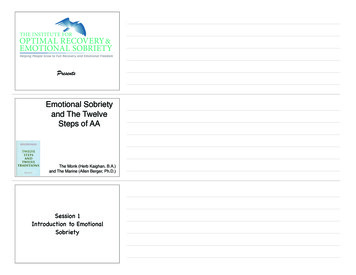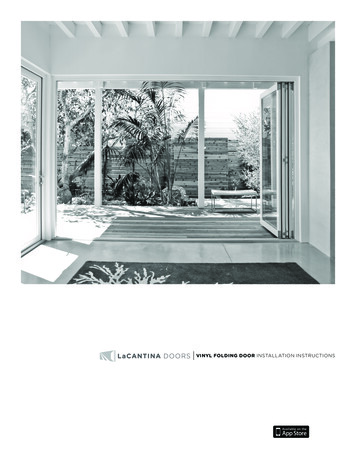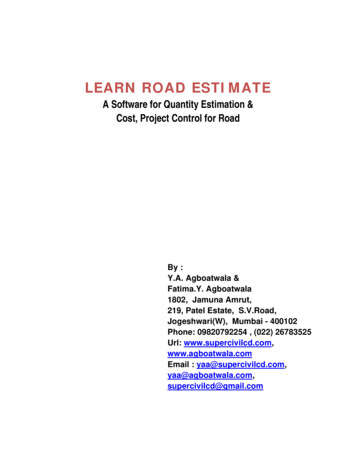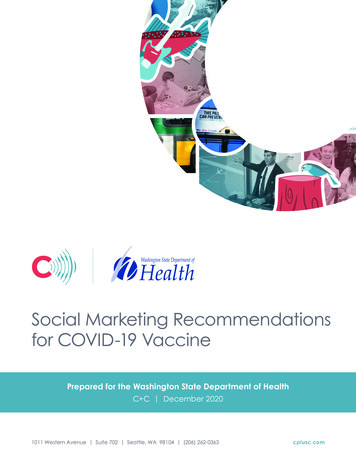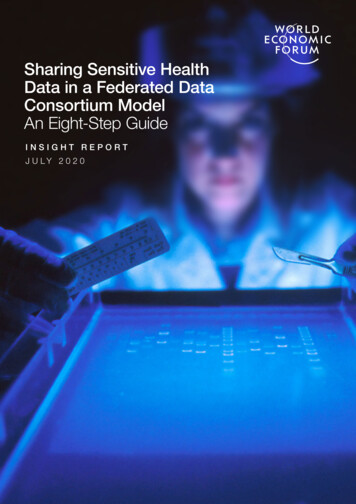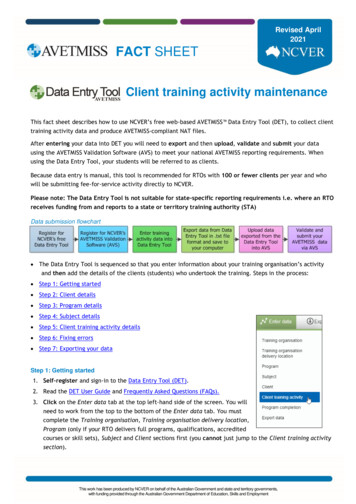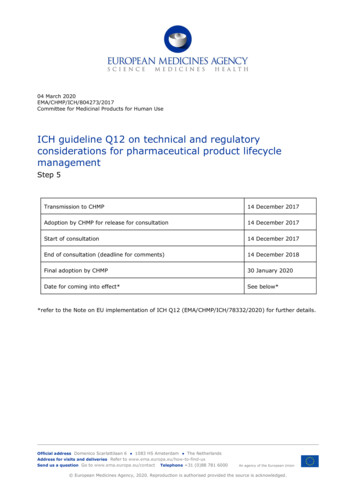
Transcription
04 March 2020EMA/CHMP/ICH/804273/2017Committee for Medicinal Products for Human UseICH guideline Q12 on technical and regulatoryconsiderations for pharmaceutical product lifecyclemanagementStep 5Transmission to CHMP14 December 2017Adoption by CHMP for release for consultation14 December 2017Start of consultation14 December 2017End of consultation (deadline for comments)14 December 2018Final adoption by CHMP30 January 2020Date for coming into effect*See below**refer to the Note on EU implementation of ICH Q12 (EMA/CHMP/ICH/78332/2020) for further details.Official address Domenico Scarlattilaan 6 1083 HS Amsterdam The NetherlandsAddress for visits and deliveries Refer to www.ema.europa.eu/how-to-find-usSend us a question Go to www.ema.europa.eu/contactTelephone 31 (0)88 781 6000An agency of the European Union European Medicines Agency, 2020. Reproduction is authorised provided the source is acknowledged.
Q12 Document HistoryCodeHistoryDateQ12Adopted by the Regulatory Members of the ICH Assembly under Step204 (document dated 19 November 2019).November2019Q12Endorsement by the Members of the ICH Assembly under Step 2 and16release for public consultation (document dated 31 October 2017).November2017ICH guideline Q12 on technical and regulatory considerations for pharmaceuticalproduct lifecycle managementEMA/CHMP/ICH/804273/2017Page 2/31
ICH guideline Q12 on technical and regulatoryconsiderations for pharmaceutical product lifecyclemanagementTable of contents1. Introduction . 41.1. Objectives . 41.2. Scope . 41.3. ICH Q12 regulatory tools and enablers . 52. Categorisation of post-approval CMC changes . 63. Established Conditions (ECs) . 73.1. Introduction. 73.2. ECs in the regulatory submission . 73.2.1. ECs definition . 73.2.2. ECs in a regulatory dossier . 73.2.3. Identification of ECs . 83.2.4. Revision of ECs . 113.3. Roles and responsibilities . 114. Post-approval Change Management Protocol (PACMP). 124.1. Definition of a PACMP. 124.2. Application of a PACMP . 124.3. Elements of a PACMP . 134.4. Modification to an Approved PACMP . 144.5. Types of PACMPs . 145. Product Lifecycle Management (PLCM) document . 145.1. PLCM Document: Scope . 145.2. Submitting the PLCM document . 155.3. Maintenance of the PLCM document . 155.4. Format and location of PLCM document . 156. Pharmaceutical Quality System (PQS) and change management . 156.1. PQS general considerations . 156.2. Change management across the supply chain and product lifecycle . 167. Relationship between regulatory assessment and inspection . 178. Structured approaches for frequent cmc post-approval changes . 179. Stability data approaches to support the evaluation of cmc changes. 1810. Glossary . 1911. References . 20Appendix 1: CTD sections that contain ECs . 21Appendix 2: principles of change management . 30ICH guideline Q12 on technical and regulatory considerations for pharmaceuticalproduct lifecycle managementEMA/CHMP/ICH/804273/2017Page 3/31
1. Introduction1.1. ObjectivesThis guideline provides a framework to facilitate the management of post-approval CMC changes in amore predictable and efficient manner. A harmonised approach regarding technical and regulatoryconsiderations for lifecycle management will benefit patients, industry, and regulatory authorities bypromoting innovation and continual improvement in the pharmaceutical sector, strengthening qualityassurance and improving supply of medicinal products.The concepts outlined in prior ICH Quality Guidelines (ICH Q8(R2), Q9, Q10 and Q11) provideopportunities for science- and risk-based approaches for use in drug development and regulatorydecisions. These guidelines are valuable in the assessment of Chemistry, Manufacturing and Controls(CMC) changes across the product lifecycle. ICH Q8(R2) and Q11 guidelines focus mostly on earlystage aspects of the product lifecycle (i.e., product development, registration and launch). Thisguideline addresses the commercial phase of the product lifecycle (as described in ICH Q10); and itboth complements and adds to the flexible regulatory approaches to post-approval CMC changesdescribed in ICH Q8(R2) and Q10 Annex 1.This guideline is also intended to demonstrate how increased product and process knowledge cancontribute to a more precise and accurate understanding of which post-approval changes require aregulatory submission as well as the definition of the level of reporting categories for such changes(i.e., a better understanding of risk to product quality). Increased knowledge and effectiveimplementation of the tools and enablers described in this guideline should enhance industry’s abilityto manage many CMC changes effectively under the company’s Pharmaceutical Quality System (PQS)with less need for extensive regulatory oversight prior to implementation. This approach canincentivize continual improvement by providing an opportunity for greater flexibility in making postapproval changes. It could also result in fewer associated post-approval submissions to the MarketingAuthorisation Application (MAA), and less associated regulatory burden. The extent of this operationaland regulatory flexibility and its adequate implementation is subject to the regulatory framework inplace, as well as product and process understanding (ICH Q8(R2) and Q11), application of quality riskmanagement principles (ICH Q9), and an effective pharmaceutical quality system (ICH Q10).Regulatory Members of ICH are encouraged to provide publicly available information, preferably ontheir website, about the implementation of ICH Q12 in their region, especially with regard to regulatoryconsiderations.1.2. ScopeThis guideline applies to pharmaceutical drug substances1 and products (both chemical and biological)that require a marketing authorization; and to drug-device combination products that meet thedefinition of a pharmaceutical or biological product. Changes needed to comply with new or revisedpharmacopoeial monographs are not within the scope of this guideline.1For drug substance information incorporated by reference (e.g., a Master File) in an MAA, the holder of the referencedinformation may use Q12 tools where applicable. Use of Q12 tools is not intended to change the responsibilities for theholder of the referenced information, the MAH or the regulatory authority. For example, the holder of the referencedinformation has a responsibility to report relevant drug substance changes to the MAH referencing their submission, sothat the MAH can assess the impact of the change and report any related changes to the approved MAA, as necessary andper regional requirements.ICH guideline Q12 on technical and regulatory considerations for pharmaceuticalproduct lifecycle managementEMA/CHMP/ICH/804273/2017Page 4/31
1.3. ICH Q12 regulatory tools and enablersUse of the following harmonised regulatory tools and enablers with associated guiding principles, asdescribed in this guideline, will enhance the management of post-approval changes, and transparencybetween industry and regulatory authorities, supporting innovation and continual improvement. Categorisation of Post-Approval CMC Changes (Categorisation of post-approval CMC changes)Categorisation of Post-Approval CMC Changes describes a framework that encompasses a riskbased categorisation for the type of communication expected of the Marketing Authorisation Holder(MAH) with the regulatory authority regarding CMC changes. Established Conditions (ECs) (Established Conditions (ECs))The concept of ECs provides a clear understanding between the MAH and regulatory authoritiesregarding the elements to assure product quality and that involve a regulatory communication, ifchanged. This guideline describes how ECs are identified as well as what information can bedesignated as supportive information that would not involve a regulatory communication, ifchanged. In addition, guidance is included for managing revisions of the ECs. Post-Approval Change Management Protocol (PACMP) (4. )The PACMP is a regulatory tool that provides predictability regarding the information required tosupport a CMC change and the type of regulatory submission based on prior agreement betweenthe MAH and regulatory authority. Such a mechanism enables planning and implementation offuture changes to ECs in an efficient and predictable manner. Product Lifecycle Management (PLCM) Document (5. )The PLCM document serves as a central repository for the ECs and the associated reportingcategory for changes made to ECs. The document also captures how a product will be managedduring the commercial phase of the lifecycle including relevant post-approval CMC commitmentsand PACMPs. Pharmaceutical Quality System (PQS) and Change Management (6. )An effective PQS as described in ICH Q10 and compliance with regional GMPs are necessary to gainfull benefit from this guideline. In particular, management of manufacturing changes across thesupply chain is an essential part of an effective change management system. This guidelineprovides recommendations for robust change management across single or multiple entitiesinvolved in the manufacture of a pharmaceutical product. Relationship Between Regulatory Assessment and Inspection (7. )This guideline outlines the complementary roles of regulatory assessment and inspection in theoversight of post-approval changes; and how communication between assessors and inspectorsfacilitates the use of the tools included herein. Structured Approaches for Frequent CMC Post-Approval Changes (8. )In addition to the other tools described above, this guideline describes a strategy for a structuredapproach applicable to frequent CMC changes, and a discussion of data expectations, to enable theuse of immediate or other post-implementation notification. Stability Data Approaches to Support the Evaluation of CMC Changes (9. )ICH guideline Q12 on technical and regulatory considerations for pharmaceuticalproduct lifecycle managementEMA/CHMP/ICH/804273/2017Page 5/31
This guideline provides additional science- and risk-based approaches that are relevant tostrategies for confirmatory stability studies to enable more timely implementation of CMC changes.Tools and enablers described above are complementary and are intended to link different phases of theproduct lifecycle. Pharmaceutical development activities result in an appropriate control strategy,elements of which are considered to be Established Conditions. All CMC changes to an approvedproduct are managed through a company’s Pharmaceutical Quality System; changes to ECs mustalso be reported to the regulatory authority. Where the regulatory system provides forCategorisation of Post-approval CMC Changes for reporting according to risk, the MAH maypropose reporting categories for changes to ECs based on risk and knowledge gained throughenhanced pharmaceutical development. A system with risk-based reporting categories also facilitatesthe use of Post-Approval Change Management Protocols, which provide predictability regardingplanning for future changes to ECs. The Product Lifecycle Management Document is a summarythat transparently conveys to the regulatory authority how the MAH plans to manage post-approvalCMC changes. The tools and enablers in this guideline do not change the Relationship BetweenRegulatory Assessment and Inspection; however, collaboration and communication betweenassessors and inspectors are necessary for the implementation of this guideline by regulators. Thisguideline provides Structured Approaches for Frequent CMC Post-Approval Changes to enablethe implementation of certain CMC changes for authorised products without the need for priorregulatory review and approval. Finally, this guideline provides Stability Data Approaches toSupport the Evaluation of CMC Changes; i.e., where the stability study is undertaken to confirmpreviously approved storage conditions and shelf-life.2. Categorisation of post-approval CMC changesRegulatory mechanisms that allow the timely and efficient introduction of CMC changes are importantfor drug quality, safety, and availability. There is a range of potential CMC changes for whichcommunication between a company and the regulatory authority is required. CMC changes vary fromlow to high potential risk with respect to product quality, safety, and efficacy. A well-characterised,risk-based categorisation of regulatory communication requirements is important to the efficient use ofindustry and regulatory resources.In such a regulatory system, the types of CMC changes that occur during the commercial phase of thepharmaceutical product lifecycle that invoke communication with regulatory authorities are classifiedwith regard to the potential to have an adverse effect on product quality of the drug product. Theregulatory communication category, supporting information/documentation requirements, andassociated time frame for evaluation are commensurate with that potential risk. Based on potentialrisk, an inspection may be needed.Regulatory authorities are encouraged to utilise a system that incorporates risk-based regulatoryprocesses for (a) requesting prior approval from the regulatory authority, (b) notifying the regulatoryauthority, or (c) simply recording CMC changes, with associated information requirements and, whereapplicable, timeframes for decision. Such a system would include the following categories forregulatory communications with one or more levels in each case: Prior approval: Certain changes are considered to have sufficient risk to require regulatoryauthority review and approval prior to implementation and are requested by the MAH in a suitablydetailed regulatory submission. Notification: Certain moderate- to low-risk changes are judged to not require prior approval andgenerally require less information to support the change. These changes are communicated to theregulatory authority as a formal notification that takes place within a defined period of time beforeICH guideline Q12 on technical and regulatory considerations for pharmaceuticalproduct lifecycle managementEMA/CHMP/ICH/804273/2017Page 6/31
or after implementation, according to regional requirements. A mechanism for immediatenotification is useful when prior approval is not required, but timely awareness of the change bythe regulator is considered necessary.In addition, the changes that are not required to be reported to regulators are only managed anddocumented within the PQS, but may be verified during routine or other inspection.Harmonisation or convergence toward a system of risk-based categorisation of post-approval changesis encouraged as an important step toward achieving the objectives of this guideline. Such a systemprovides inherent, valuable flexibility in regulatory approach and a framework that can supportadditional regulatory opportunities such as: Facilitating the use of tools and enablers described in this guideline by providing a range of requestand notification categories available as a target for a lowering of regulatory submissionrequirements. The use of a lower category for request/notification if certain criteria/conditions are met and therelevant supporting documentation is provided as described in regional regulatory guidance; theneed for regulatory inspection associated with the change may preclude the ability to use a lowercategory. Providing options for converging to the same or similar reporting category as that in otherjurisdictions.A risk-based categorisation system may be accomplished by having the principles captured inregulations with further details in guidance, which can provide additional flexibility to modifyexpectations as science and technology evolve. For examples of risk-based categorisation systems,refer to existing regulations and guidance of ICH members, and WHO guidelines and guidance onchanges to authorised products.3. Established Conditions (ECs)3.1. IntroductionThis guideline establishes a harmonised approach to defining which elements in an application areconsidered necessary to assure product quality and therefore would require a regulatory submission ifchanged post-approval. These elements are being defined in this guideline as “Established Conditionsfor Manufacturing and Control” (referred to as ECs throughout this guideline).3.2. ECs in the regulatory submission3.2.1. ECs definitionECs are legally binding information considered necessary to assure product quality. As a consequence,any change to ECs necessitates a submission to the regulatory authority.3.2.2. ECs in a regulatory dossierThis chapter describes scientific risk-based approaches which can be used when defining ECs and theirreporting categories. Regional legal frameworks, supplemented through regulation and guidance, maydefine ECs with their reporting categories and/or may allow the scientific risk-based approachesdescribed in this chapter to be considered.ICH guideline Q12 on technical and regulatory considerations for pharmaceuticalproduct lifecycle managementEMA/CHMP/ICH/804273/2017Page 7/31
All regulatory dossiers contain a combination of ECs and supportive information. Supportiveinformation is not considered to be ECs but is provided to share with regulators the development andmanufacturing information at an appropriate level of detail. Knowledge gained throughout the productlifecycle (including pharmaceutical development and characterisation of chemical and biological drugsubstance and drug product) is the basis for identifying the elements of CMC that are ECs and thoseelements which are supportive information.An MAH should clearly identify the elements of CMC which they consider to be an EC and those whichthey consider to be supportive information. The rationales for the ECs are provided in the appropriateCTD modules.Similarly, the rationales for the associated reporting categories for changes to the ECs should beprovided in the appropriate CTD modules. The regulator assesses the ECs with respect to establishedscientific guidelines. Where appropriate, regulators approve the EC and associated reporting categoryin line with the principles outlined in 2. .See 20 for more information regarding sections of the dossier that contain ECs and supportiveinformation. Unless otherwise specified by regulatory requirement identifying ECs for a given productis not mandatory.ECs should not be confused with CMC regulatory commitments (e.g., stability, post-approval CMCcommitment and other commitments) made by a MAH to provide data or information to the regulatoryagency in a MAA. Such information, in the context of this guideline, is considered supportiveinformation. Changes to CMC regulatory commitments are managed according to existing regionalregulations and guidance.3.2.3. Identification of ECsThis chapter outlines approaches to define ECs for manufacturing processes and analyticalprocedures. A similar approach can be used to define other types of ECs (e.g., performance of thecontainer closure system, device elements of drug-device combination products) and should bejustified by the applicant and approved by the regulatory agency.The extent of ECs may vary based on the company’s development approach, product and processunderstanding, and the potential risk to product quality. Appropriate justification should be provided insupport of the identification of ECs, the proposed reporting categories for ECs, and those aspects thatare not ECs.3.2.3.1. Identification of ECs for the manufacturing processesA control strategy is designed to ensure that a product of required quality will be produced consistently(ICH Q8(R2)). It is a planned set of controls, derived from current product and process understanding,that assures process performance and product quality. The controls can include parameters andattributes related to drug substance and drug product materials and components, facility andequipment operating conditions, in-process controls, finished product specifications, and the associatedmethods and frequency of monitoring and control (ICH Q10).The ECs for a manufacturing process should be defined, based on product and process understanding,taking into account all the relevant elements of the control strategy. In addition to the unit operationand the sequence of steps, and in considering the overall control strategy, ECs proposed and justifiedin a manufacturing process description should be those inputs (e.g., process parameters, materialattributes) and outputs (that may include in-process controls) that are necessary to assure productquality.ICH guideline Q12 on technical and regulatory considerations for pharmaceuticalproduct lifecycle managementEMA/CHMP/ICH/804273/2017Page 8/31
Process parameters that need to be controlled to ensure that a product of required quality will beproduced should be considered ECs. These ECs are identified through an initial risk assessment andapplication of knowledge gained from executed studies, prior knowledge, and a criticality assessmentthat determines the level of impact that a process parameter could have on product quality. Thecriticality assessment should account for severity of harm and whether the ranges studied sufficientlyaccount for the expected variability in the EC. CPPs and other process parameters where an impact onproduct quality cannot be reasonably excluded should be identified as ECs.Once ECs are identified, an updated assessment of the potential risk to product quality associated withchanging the EC, taking into account the overall control strategy informs the reporting category for theEC. The assessment of potential risk is derived from risk management activities as described in ICHQ9. The output of the risk assessment can include changes to manufacturing process ECs that rangefrom high to low risk to product quality. The reporting category should be defined based on level ofrisk. A justification of the potential risk for changing ECs and corresponding reporting categories shouldbe provided.A decision tree which illustrates the above step-wise approach to identifying ECs and reportingcategories for process parameters is shown in Figure 1. The principles in the decision tree can beapplied to identify ECs for other parts of the manufacturing process and control strategy (e.g., relevantelements of input material attributes, equipment, and in-process controls) and associated reportingcategories.Figure 1: Decision Tree for Identification of ECs and Associated Reporting Categories forManufacturing Process ParametersThe details of ECs and the associated reporting category will depend on the extent to which thecompany can apply knowledge from product and process understanding (i.e., development andexperience accumulated throughout the product lifecycle) to manage the risks to product quality.ICH guideline Q12 on technical and regulatory considerations for pharmaceuticalproduct lifecycle managementEMA/CHMP/ICH/804273/2017Page 9/31
Different approaches can be used alone, or in combination, to identify ECs for manufacturingprocesses; these include, but are not limited to the following: Parameter-based approaches, including: A minimal2 approach, with a limited understanding of the relationship between inputs andresulting quality attributes, will include a large number of inputs (e.g., process parameters andmaterial attributes) along with outputs (including in-process tests). An enhanced approach with increased understanding of interaction between inputs andproduct quality attributes together with a corresponding control strategy can lead toidentification of ECs that are focused on the most important input parameters along withoutputs, as appropriate. In a performance-based approach, ECs could be primarily focused on control of process outputs(e.g., attributes, measurements, responses) rather than process inputs (e.g., process parametersand material attributes). This is enabled by knowledge gained from an enhanced approach, adata-rich environment, and an enhanced control strategy (e.g., models, Process AnalyticalTechnology (PAT)). For example, a performance-based approach could be considered formanufacturing process steps with in-line monitoring of relevant attributes or with feedback controlsor optimisation algorithms to achieve the relevant targets for that process step. When consideringthis approach, it is important to ensure that all relevant parameters and material attributes thathave a potential to impact product quality are monitored and equipment used remains qualified inorder to assure a stable process It should be noted that not all elements of the decision tree inFigure 1 apply because the enhanced control strategy used may remove the need for certainprocess parameters to be ECs.Use of this guideline should not lead to providing a less detailed manufacturing process description inthe MAA. A suitably detailed description of the manufacturing process in Module 3 is expected toprovide a clear understanding regardless of the approach used to identify ECs for manufacturingprocess parameters. Manufacturing process descriptions include supportive information as well asidentified ECs. Information regarding product-specific post-approval change activities, such as postchange monitoring, may be provided as supporting information to aid in the determination of ECs andassociated reporting categories. Criticality and risk should be periodically reviewed (as expected byICH Q10) during the lifecycle of the product and the ECs and reporting categories should be updatedbased on acquired knowledge.When implementing the change, and consistent with 30, an MAH should consider the impact of theplanned change, whether concurrent changes are planned, and if the originally proposed reportingcategory should be revised.This guidance does not impose additional regulatory filing expectations for process ECs due to nonconformance during routine operations. Non-conformance to process-related ECs should be handled inaccordance with GMP regulations (i.e., deviation/non-conformance handling process).3.2.3.2. Identification of ECs for analytical proceduresSimilar to the principles described for manufacturing process, ECs related to analytical proceduresshould include elements which assure performance of the procedure. The extent of ECs and theirreporting categories could vary based on the degree of the understanding of the relationship betweenmethod parameters and method performance, the method complexity, and control strategy. A2Also referred to as “traditional” in ICH Q11.ICH guideline Q12 on technical and regulatory considerations for pharmaceuticalproduct lifecycle managementEMA/CHMP/ICH/804273/2017Page 10/31
justification to support the identification of ECs and corresponding reporting categories for changes toECs based on risk management should be provided.Different approaches can be used to identify ECs for analytical procedures, for example as analyticaltechnology and development approaches advance; these approaches include, but are not limited to thefollowing: When more limited development studies have been conducted this may result in a narrowoperating window to ensure method performance. In such cases ECs may be more extensive withfixed and/or tight conditions. Enhanced understanding can lead to a wider operating window that ensures method performance,where ECs can be reduced and focused on method performance (e.g., method parametersacceptable ranges rather than set points, performance criteria).Use of this guideline should not lead to providing a less detailed description of analytical procedures inthe MAA. A suitably detailed description of the analytical procedures in Module 3 is expected toprovide a clear under
Pharmaceutical Quality System (PQS) and Change Management (6. ) An effective PQS as described in ICH Q10 and compliance with regional GMPs are necessary to gain full benefit from this guideline. In particular, management of manufacturing changes across the supply chain is an essential part of an effective change management system. This .
